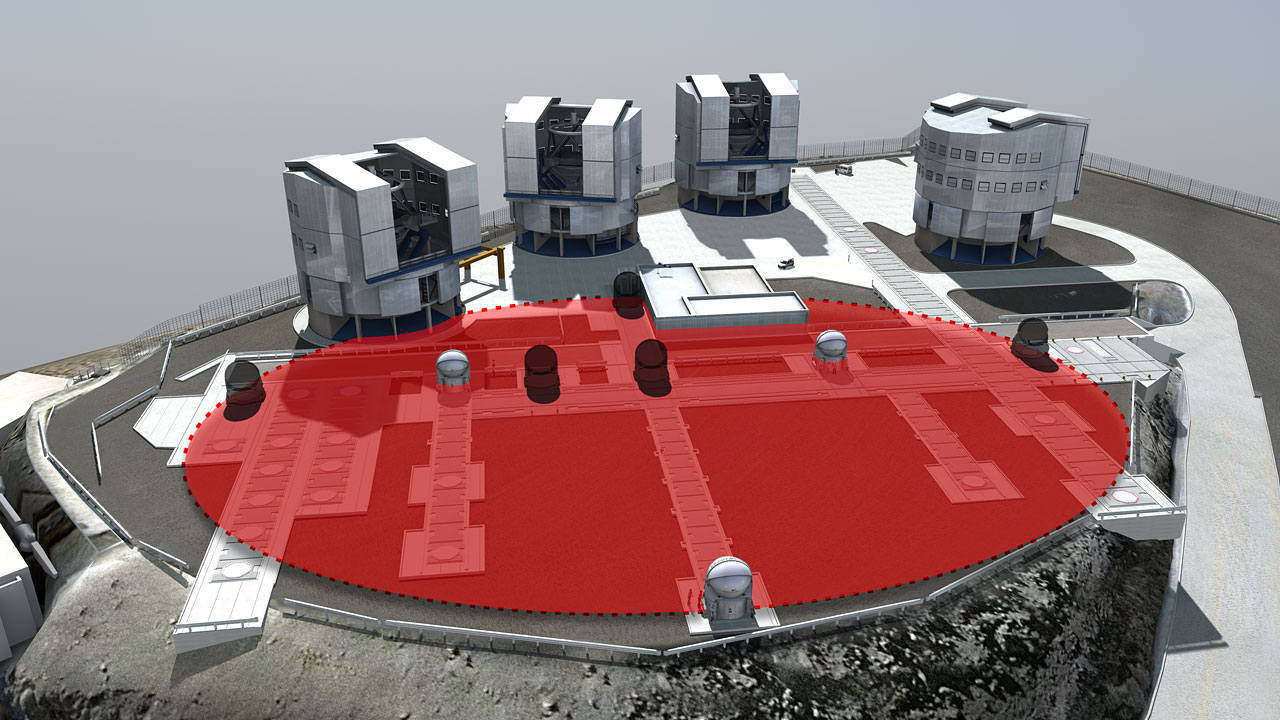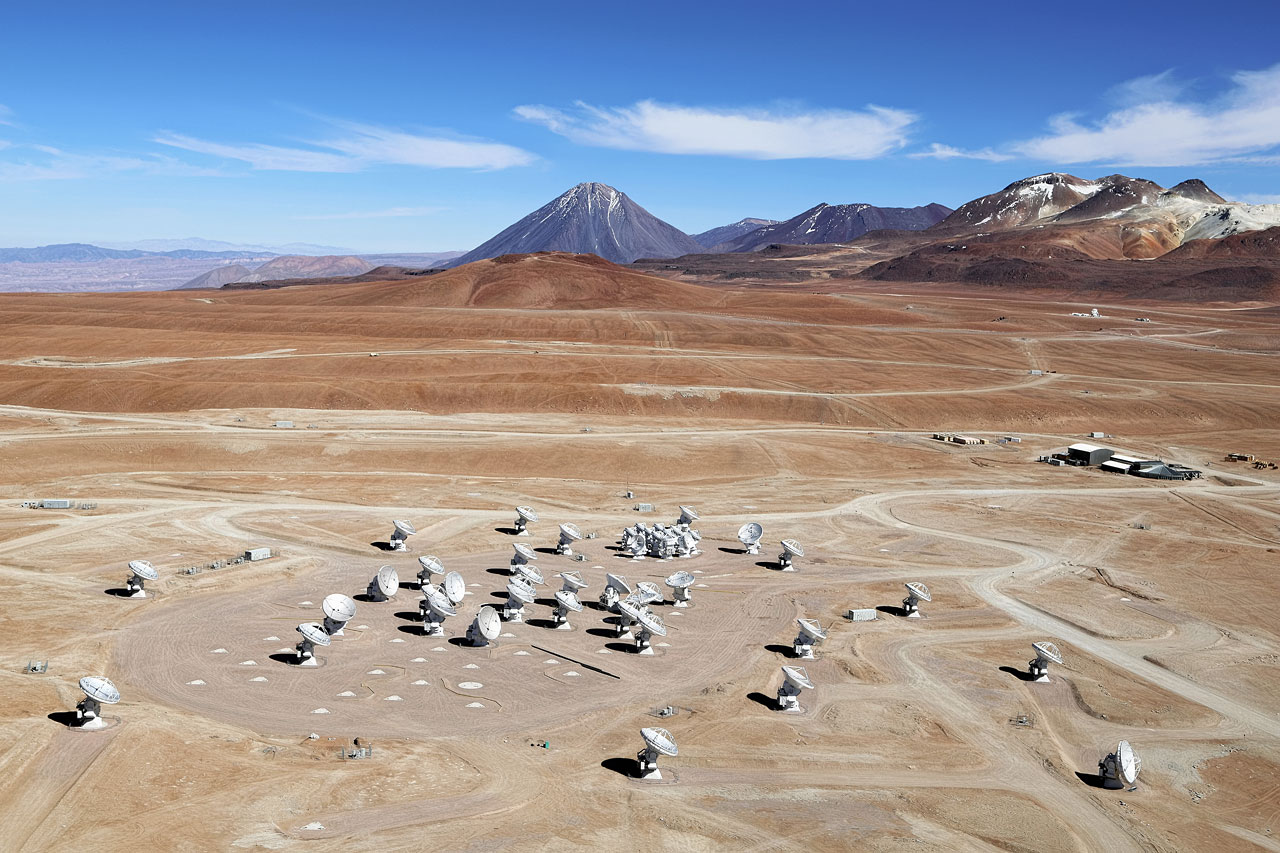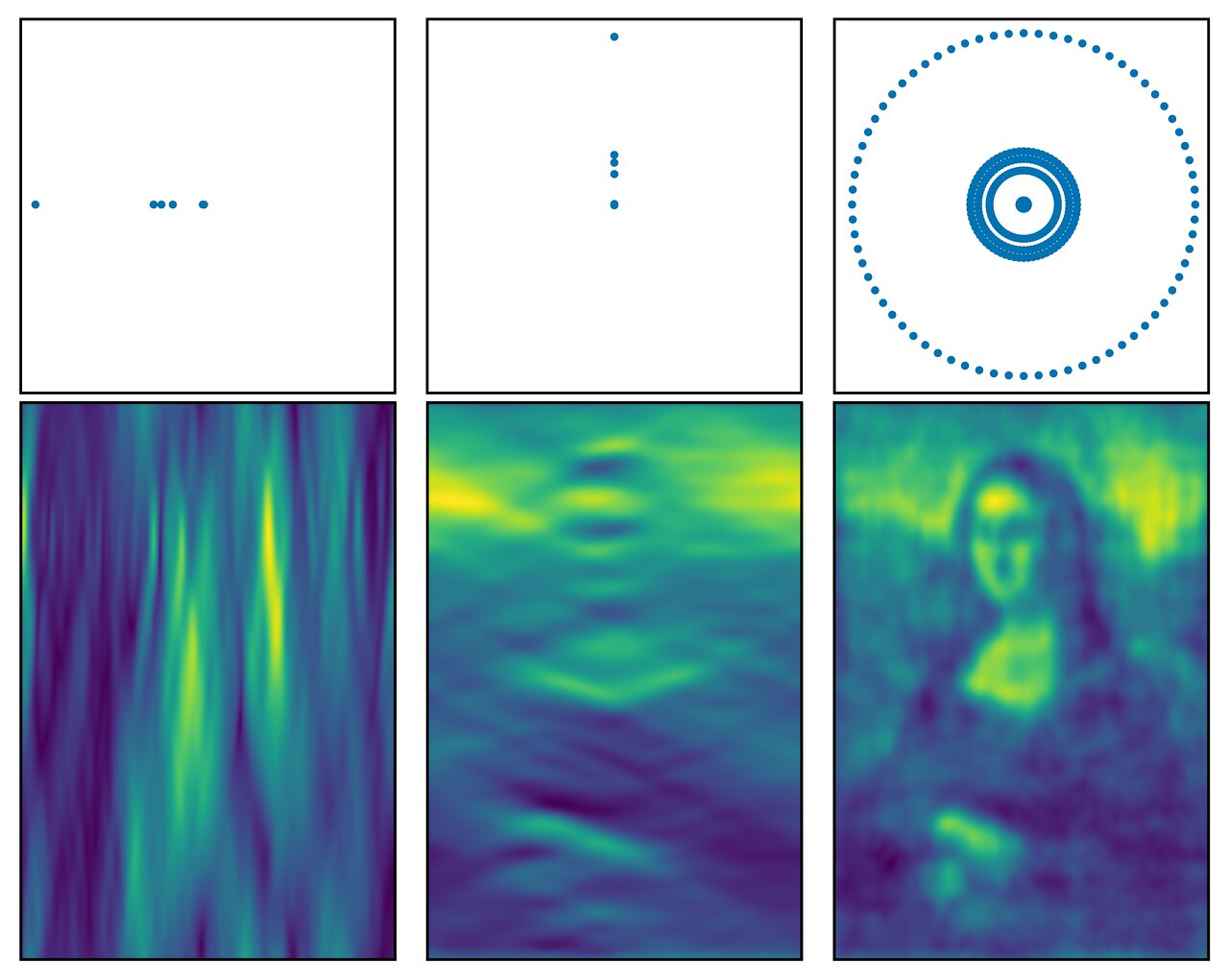Interferometry
- What is interferometry? From this page, you will learn...
- Why do we want to build larger telescopes?
- What technical challenges do large telescopes present?
- Why do we use interferometry?
- How does ESO use interferometry?
- How does the wavelength of the observed light impact the interferometer?
- How do the number and position of the antennas determine the final image?
- What does interference actually look like?
- How do you reconstruct the observed object from the fringe pattern?
- What is very long baseline interferometry, the technique used by the Event Horizon Telescope?
- What are some of ESO’s science highlights achieved with interferometry?
What is interferometry? From this page, you will learn...
- That interferometry is a technique often applied in astronomy that allows us to pick up details that even the largest telescopes today cannot resolve. The light from two or more telescopes is combined to create an image of a celestial object with much finer detail than what would be possible with each individual telescope. In this way, the multiple telescopes act as one giant, “virtual” telescope, or an interferometer, with a diameter much larger than that of any real-life telescope.
- That interferometry is used to study all types of celestial objects, from cold gas clouds, to exoplanets, details on the surfaces of stars, and even the environments around black holes.
- How ESO plays a role in two interferometry projects: ESO’s Very Large Telescope Interferometer (VLTI) and the Atacama Large Millimetre/submillimetre Array (ALMA).
Why do we want to build larger telescopes?
To deepen our understanding of the Universe, astronomers need to pick up finer and finer details of cosmic objects. This can be achieved by increasing the size of a telescope’s primary mirror: the larger the mirror diameter, the higher its resolution — that is, the better its ability to distinguish such small details. The hunger for even better resolutions is the reason for the use of interferometry in astronomy.
What technical challenges do large telescopes present?
Building mirrors larger than a few metres in diameter is both expensive and an engineering challenge. The main issue to overcome is that the mirror's own weight causes it to sag and deform due to the effects of gravity.
The use of active optics below the mirror to control and compensate for deformations has enabled the jump from telescopes with mirror diameters of around 4 metres, like ESO’s New Technology Telescope (NTT), to the current 8- to 10-metre generation of optical telescopes, like the Very Large Telescope (VLT). Using segmented mirrors with active optics, the planned ESO’s Extremely Large Telescope (ELT) will have a mirror that is 39 metres in diameter. However, even this is still too small to see the details on the surface of even a nearby star!
For radio astronomy, the fine details are even more difficult to resolve. At an equivalent diameter, a radio telescope has a resolution 1000 times worse than a visible-light telescope. This is simply because radio waves, such as those observed by ALMA, have a much longer wavelength than visible-light waves, hence produce lower resolution observations. To pick out the same features as the VLT, a single radio dish with a diameter of several kilometres would be needed.
Why do we use interferometry?
Given the limit to the diameter of mirrors and antennas we can produce, astronomers therefore turn to interferometry, by combining two or more telescopes to create a “virtual” instrument, called an interferometer. This acts as though it is a single telescope with a diameter equivalent to the size of the separation between the individual telescopes (or the baseline).
One disadvantage of interferometry is that less light is collected on the separate mirrors/antennas of the array, than if one telescope as large as the array was used — it is as if there are gaps in the light collecting surface of the virtual telescope. This means that interferometry works best when observing bright celestial sources, and it is ideal for picking out very small details on these objects.
How does ESO use interferometry?
ESO uses interferometry on two flagship scientific projects: the VLTI and ALMA.
- VLTI: with ESO’s VLTI, astronomers can probe many research fields in astronomy and are able to distinguish details on the surfaces of stars. Using this interferometer, astronomers have obtained one of the sharpest images ever of a star, with a resolution equivalent to picking out the head of a screw at a distance of 300 kilometres!
The VLTI probes the Universe in near and mid-infrared wavelengths and combines the light of either the four 8.2-metre Unit Telescopes (UTs) or of the four 1.8-metre Auxiliary Telescopes (ATs) of the VLT:- The UTs can form six baselines, all with different lengths and orientations — this is the reason for the curious arrangement of the telescopes on the VLT platform. This yields a maximum possible resolution equivalent to a telescope 130 metres in diameter. This corresponds to its largest available baseline, 16 times greater than a single UT.
- The ATs can be moved to 30 different locations along the VLT platform to obtain more information about the observed cosmic object. This provides a much larger number of possible baselines and enables the VLTI to achieve a maximum possible resolution equivalent to a telescope of 200 metres in diameter (at present, the VLTI is operated with baselines up to 140m). This is an improvement of up to 25 times on a single UT.
- ALMA: ALMA, an international project in which ESO is a partner, looks at the Universe in the millimeter and submillimeter wavelengths. These wavelengths are emitted by cool objects like gas clouds — only a few tens of degrees above absolute zero — and by some of the earliest and most remote galaxies in the Universe. Astronomers use ALMA to study molecular gas clouds, the building blocks of stars, planetary systems, galaxies and life itself.
ALMA can combine up to 66 antennas, with 1225 baselines, and a maximum distance of 16 kilometres between the antennas. Thus, ALMA has by far the highest resolution available in radio astronomy, up to ten times better than that achieved, at visible wavelengths, by the NASA/ESA Hubble Space Telescope.
How does the wavelength of the observed light impact the interferometer?
As we explained above, long wavelengths require larger telescopes to produce images with the same resolution as short wavelengths. The same holds for interferometers. This is why the typical baselines of the VLTI, which observes in the near infrared, are a few tens of meters long, while those at ALMA, which probes the cosmos at radio wavelengths, span some kilometers.
On the other hand, longer wavelengths are easier to combine. The reason is that our current technology is advanced enough to digitalise radio waves, but not infrared signals yet. Hence, while the interference of radio waves can be performed electronically on computers, infrared signals must be physically combined with each other, which demands dedicated, complex facilities. This is why radio interferometry was first developed and why ALMA and the VLTI combine their signals in very different ways.
In the case of ALMA, radio waves are combined digitally inside a powerful computer called correlator. But even supercomputers like the ALMA correlator are not capable of reaching the level of precision needed to successfully combine signals in the infrared domain. It took decades to develop a reliable system for infrared interferometry, like the one used at the VLTI.
Instead of a supercomputer, the VLTI uses a system of underground tunnels, known as delay lines. As the light waves from the observed cosmic object travel through both space and the Earth’s atmosphere, they arrive at each telescope at slightly different times. These delay lines add an extra distance into the paths travelled by the earliest arriving waves. This introduces compensatory time delays which ensure that all the waves from the object are combined correctly. This delay is achieved with a system of several carriages with mirrors that move along rails with the same length as the VLTI’s maximum baseline. By carefully positioning these carriages, the incoming signals can be fine-tuned to an astonishing precision of 1/1000 mm.
How do the number and position of the antennas determine the final image?
The images that an interferometer can produce are dependent on the geometry of the array; in particular the number and arrangement of the baselines.
What happens if you change the shape of the array? This example shows what the Mona Lisa would look like if viewed by an interferometer made up of radio antennas placed in different configurations.
When the antennas are placed in a horizontal line, only horizontal details of the image can be picked out. In the same way, when the antennas are placed in a vertical line, you can only see vertical details of the image.
To create a better image, a combination of not only horizontal and vertical but all directions is required. This can be achieved either by physically moving the telescopes, or by utilising the Earth’s rotation. As the Earth spins, the orientation of the various baselines with respect to the observed object changes. As a result, more information and data is acquired. This technique is crucial when using the VLTI, as it is made up of only four telescopes and therefore has very few baselines.
In interferometry, the resolution depends not on the size of the telescope’s mirror or antenna, but on the size of the baseline. The larger the baseline, the higher the resolution of the observed object.
The example below shows that, as the antennas in the ALMA array are placed further and further apart, more and more detail is revealed in the Mona Lisa. However, a point is reached where only very fine details can be seen; larger aspects of the image (such as the distinction between sky and woman) are lost because their interference patterns wash out.
This is why ALMA consists of a smaller, central compact array — which reveals large-scale aspects of an image — and antennas that can be placed up to 16km apart — revealing the finer details. Other interferometers use similar principles.
Adding more antennas or mirrors to an interferometer array has therefore two effects. The first is to increase the number of baselines, and hence the number of different separations between pairs of elements in the array, revealing details at different scales. The second is to introduce new angles and orientations of these baselines which also helps to produce a more complete image.
What does interference actually look like?
When two or more waves meet, they can combine to create an overall wave. This phenomenon is called interference, and is the principle which interferometry is based on.
A real-life example of interference can be seen as ripples on the surface of water. Imagine a perfectly still pond and then think of dropping two pebbles into it side by side. Each pebble produces an expanding system of circular ripples, and at some point the two sets of ripples will begin to overlap. Where two wave crests or troughs of the ripples meet, the height of the wave doubles –– we call this constructive interference. However, if the crest of one wave meets the trough of another, they cancel each other out –– this is known as destructive interference.
Instead of water waves, interference in astronomy uses light waves. The combined light waves are called interference fringes.
The following illustration shows in a schematic way how two stars of different apparent size in the sky as seen from Earth (left) will look like when observed with a single telescope (middle) and with an interferometer like the VLTI, which forms the interference fringes (right). The bright and dark bands in the fringe pattern result from constructive and destructive interference, respectively. There is little difference when observing the star through one telescope, but the fringe patterns at the interferometer are quite different.
How do you reconstruct the observed object from the fringe pattern?
The width and brightness of the fringes mainly depend on three factors: the baseline of the interferometer, the wavelength of the two light waves being combined and the object’s apparent size in the sky as seen from Earth. The first two are known, which allows us to work out the object’s size.
With very few baselines it is not possible to reconstruct an image of an object; astronomers can only infer some basic geometric properties, such as the diameter of a star or whether it has a companion. Adding more baselines with different separations and orientations allows a more faithful reconstruction of the shape of the object.
What is very long baseline interferometry, the technique used by the Event Horizon Telescope?
Very-Long-Baseline Interferometry (VLBI) combines the signals collected by radio telescopes located hundreds or thousands of kilometers apart, stretching the baselines to the maximum lengths possible on Earth to create a “virtual” telescope the size of the whole planet.
This increases the resolution achieved by radio interferometers, such as ALMA, by hundreds of times. This enables astronomers to view the cosmos in sharper detail to such extremes as being able to look at the shadow of the supermassive black holes lurking at the heart of galaxies.
This is the ultimate goal of the Event Horizon Telescope (EHT), a network of 11 radio telescopes scattered across the world — from Greenland to the South Pole, including ALMA and APEX in the Chilean Andes — managed by an international collaboration of more than 300 scientists from almost 80 institutions around the globe.
The primary targets of the EHT are the two largest supermassive black holes as seen from Earth: Sgr A* at the heart of our Milky Way and the one in the core of the M87 galaxy. The EHT network looks at the radio waves emitted by the disc of gas around the event horizon of the two black holes, a process which enabled astronomers to capture the first-ever image of a black hole (the supermassive black hole in M87).
As the EHT antennas are spread across continents, their signals cannot be combined and analysed on site, like in ALMA. Instead the signals must be recorded and brought together to be analysed after the observations have been performed.
With the EHT stretching across the whole planet, have we reached the longest possible baselines, hence creating a limit to how sharp we can look at the cosmos? The answer is no, as space-based VLBI is already operating with radio satellites offering even longer baselines than the size of the Earth.
Our planet will not be the ultimate frontier of interferometry but simply the beginning.
What are some of ESO’s science highlights achieved with interferometry?
VLTI’s science highlights
- First direct observation of an exoplanet using optical interferometry
- Highest-resolution image of the Eta Carinae star system (eso1637).
- Detection of exo-zodiacal light (eso1435).
- Best ever image of a star’s surface and atmosphere (eso1726).
- Sharpest view of a dusty disc around an aging star (eso1608).
- Detection of a very small companion in the protoplanetary disk around the star T Cha (eso1106).
- Detection of relativistic effects in stars orbiting the supermassive black hole at the centre of the Milky Way
ALMA’s science highlights:
- Revolutionary imaging of planetary genesis
- Extraordinarily detailed observation of an Einstein Ring
- Detection of complex organic molecules — carbon-based, prebiotic structures, necessary for building life — in distant protoplanetary disks
- First clear detection of a moon-forming disc around an exoplanet
- The first image of a black hole










